Testing a Comprehensive Volcanic Risk Assessment of Tenerife by Volcanic Hazard Simulations and Social Vulnerability Analysis
Abstract
1. Introduction
2. Study Area and Data
2.1. Study Area
2.2. Data
2.2.1. Geospatial Data
2.2.2. Geological Data
2.2.3. Socio-economic Statistics
3. Methods
3.1. Volcanic Hazard Simulations
3.1.1. Eruptive Scenarios
- Scenario 1: Sub-Plinian eruption at the central edifice. With ash fall dispersing in the atmosphere and on the ground, an explosive eruption produces an 8 km eruptive column which later forms a PDC after collapse. Associated to this eruption is a phonolitic lava flow from the central edifice.
- Scenario 2: Strombolian eruption in the basalt ridges in the NE-SW and NW-SE directions. The eruption is weaker (eruptive column 3 km high) than that at the central edifice. Basaltic lava flows downstream from high-susceptibility vents on the two ridges [12].
3.1.2. Lava Flows
3.1.3. Ash Fall
3.1.4. Pyroclastic Density Currents
3.2. Social Vulnerability Assessment
3.2.1. Indicators
3.2.2. Data Pre-Processing
3.2.3. Determining the Weight for Each Indicator
3.3. Volcanic Risk Model
4. Results
4.1. Volcanic Hazard Simulations
4.1.1. Lava Flow Simulations
4.1.2. PDC Simulation
4.1.3. Ash Fall Simulations
4.2. Social Vulnerability
4.2.1. Exposure Index
4.2.2. Sensitivity Index
4.2.3. Capability Index
4.2.4. Vulnerability of Tenerife
4.3. Volcanic Risk Assessment
5. Discussion
5.1. Volcanic Hazard Analysis
5.2. Social Vulnerability Analysis
5.3. Volcanic Risk Management
5.4. Limitations
6. Conclusions
- In Scenario 1, volcanic hazards would be more likely to occur in NE ridges and north. Northern municipalities are affected by three volcanic hazards, while northeast municipalities are mainly affected by ash fall. In Scenario 2, NE, NW ridges and east municipalities are influenced by lava flows. Ash fall is mainly distributed in the northwest and north.
- High vulnerability is expected in the southeast and northeast of Tenerife, such as Arico, Santa Ursula and Puerto de la Cruz. The socio-economic structure of such municipalities should be fully optimized to reduce volcano risk.
- In Scenario 1, high risk for three volcanic hazards is expected in the north of Tenerife, including the municipalities of La Guancha, Icode de los Vinos and San Juan de la Rambla. In Scenario 2, high risk for lava and ash fall is expected in the northwest and the east. Volcanic risk management should be strengthened in such municipalities.
Author Contributions
Funding
Acknowledgments
Conflicts of Interest
References
- Maharani, Y.N.; Lee, S.; Ki, S.J. Social vulnerability at a local level around the Merapi volcano. Int. J. Disaster Risk Reduct. 2016, 20, 63–77. [Google Scholar] [CrossRef]
- Global Volcanism Program, Smithsonian Institution. Volcanoes of the World Database. Available online: https://volcano.si.edu/search_eruption.cfm (accessed on 19 October 2018).
- Warsini, S.; Mills, J.; Usher, K. Solastalgia: Living with the Environmental Damage Caused By Natural Disasters. Prehosp. Disaster Med. 2014, 29, 87–90. [Google Scholar] [CrossRef] [PubMed]
- Witham, C.S. Volcanic disasters and incidents: A new database. J. Volcanol. Geotherm. Res. 2005, 148, 191–233. [Google Scholar] [CrossRef]
- Bartolini, S.; Becerril, L.; Martí, J. A new Volcanic managEment Risk Database desIgn (VERDI): Application to El Hierro Island (Canary Islands). J. Volcanol. Geotherm. Res. 2014, 288, 132–143. [Google Scholar] [CrossRef]
- Lirer, L.; Petrosino, P.; Alberico, I.; Postiglione, I. Long-term volcanic hazard forecasts based on Somma-Vesuvio past eruptive activity. Bull. Volcanol. 2001, 63, 45–60. [Google Scholar] [CrossRef]
- Geyer, A.; Blanco, M.J.; Martí, J.; Felpeto, A.; Aspinall, W.P.; Baxter, P.; Pacheco, J.; Sobradelo, R.; Cole, P.; Ortiz, R.; et al. A long-term volcanic hazard event tree for Teide-Pico Viejo stratovolcanoes (Tenerife, Canary Islands). J. Volcanol. Geotherm. Res. 2008, 178, 543–552. [Google Scholar]
- Sobradelo, R.; Martí, J. Bayesian event tree for long-term volcanic hazard assessment: Application to Teide-Pico Viejo stratovolcanoes, Tenerife, Canary Islands. J. Geophys. Res. Solid Earth 2010, 115, 1–12. [Google Scholar] [CrossRef]
- Araña, V.; García, A.; Astiz, M.; Felpeto, A.; Abella, R.; Ortiz, R. Zonation of the main volcanic hazards (lava flows and ash fall) in Tenerife, Canary Islands. A proposal for a surveillance network. J. Volcanol. Geotherm. Res. 2002, 103, 377–391. [Google Scholar] [CrossRef]
- Martí, J.; Sobradelo, R.; Felpeto, A.; García, O. Eruptive scenarios of phonolitic volcanism at Teide-Pico Viejo volcanic complex (Tenerife, Canary Islands). Bull. Volcanol. 2012, 74, 767–782. [Google Scholar] [CrossRef]
- Alcorn, R.; Panter, K.S.; Gorsevski, P.V. A GIS-based volcanic hazard and risk assessment of eruptions sourced within Valles Caldera, New Mexico. J. Volcanol. Geotherm. Res. 2013, 267, 1–14. [Google Scholar] [CrossRef][Green Version]
- Scaini, C.; Felpeto, A.; Martí, J.; Carniel, R. A GIS-based methodology for the estimation of potential volcanic damage and its application to Tenerife Island, Spain. J. Volcanol. Geotherm. Res. 2014, 278–279, 40–58. [Google Scholar] [CrossRef]
- Scandone, R.; Bartolini, S.; Martí, J. A scale for ranking volcanoes by risk. Bull. Volcanol. 2016, 78, 1–8. [Google Scholar] [CrossRef]
- Martí, J.; Ortiz, R.; Gottsmann, J.; Garcia, A.; De La Cruz-Reyna, S. Characterising unrest during the reawakening of the central volcanic complex on Tenerife, Canary Islands, 2004-205, 0and implications for assessing hazards and risk mitigation. J. Volcanol. Geotherm. Res. 2009, 182, 23–33. [Google Scholar] [CrossRef]
- Gómez-Fernández, F. Application of a GIS algorithm to delimit the areas protected against basic lava flow invasion on Tenerife Island. J. Volcanol. Geotherm. Res. 2000, 103, 409–423. [Google Scholar] [CrossRef]
- Gomez-Fernandez, F. Development of a Volcanic Risk Assessment Information System for the Prevention And Management Of Volcanic Crisis: Stating The Fundamentals. WIT Trans. Inf. Commun. Technol. 1970, 21. [Google Scholar] [CrossRef]
- Marti, J.; Spence, R.; Calogero, E.; Ordoñez, A.; Felpeto, A.; Baxter, P. Estimating building exposure and impact to volcanic hazards in Icod de los Vinos, Tenerife (Canary Islands). J. Volcanol. Geotherm. Res. 2008, 178, 553–561. [Google Scholar] [CrossRef]
- Marrero, J.M.; García, A.; Llinares, A.; Rodriguez-Losada, J.A.; Ortiz, R. A direct approach to estimating the number of potential fatalities from an eruption: Application to the Central Volcanic Complex of Tenerife Island. J. Volcanol. Geotherm. Res. 2012, 219–220, 33–40. [Google Scholar] [CrossRef]
- PHIVOLCS. Introduction to Volcanoes. Available online: https://www.phivolcs.dost.gov.ph/index.php/volcano-hazard/introduction-to-volcanoes (accessed on 1 March 2020).
- Branney, M.; Acocella, V. Calderas. In The Encyclopedia of Volcanoes; Academic Press: Amsterdam, The Netherlands, 2015; pp. 299–315. [Google Scholar]
- Felpeto, A.; Martí, J.; Ortiz, R. Automatic GIS-based system for volcanic hazard assessment. J. Volcanol. Geotherm. Res. 2007, 166, 106–116. [Google Scholar] [CrossRef]
- Marti, J.; Felpeto, A. Methodology for the computation of volcanic susceptibility. An example for mafic and felsic eruptions on Tenerife (Canary Islands). J. Volcanol. Geotherm. Res. 2010, 195, 69–77. [Google Scholar] [CrossRef]
- Carracedo, J.C.; Rodríguez Badiola, E.; Guillou, H.; Paterne, M.; Scaillet, S.; Pérez Torrado, F.J.; Paris, R.; Fra-Paleo, U.; Hansen, A. Eruptive and structural history of Teide Volcano and rift zones of Tenerife, Canary Islands. Bull. Geol. Soc. Am. 2007, 119, 1027–1051. [Google Scholar] [CrossRef]
- Martí, J.; Geyer, A.; Andujar, J.; Teixidó, F.; Costa, F. Assessing the potential for future explosive activity from Teide-Pico Viejo stratovolcanoes (Tenerife, Canary Islands). J. Volcanol. Geotherm. Res. 2008, 178, 529–542. [Google Scholar] [CrossRef]
- Martí, J. Las Cañadas caldera, Tenerife, Canary Islands: A review, or the end of a long volcanological controversy. Earth-Sci. Rev. 2019, 196, 102889. [Google Scholar] [CrossRef]
- Solana, M.C. Development of unconfined historic lava flow fields in Tenerife: Implications for the mitigation of risk from a future eruption. Bull. Volcanol. 2012, 74, 2397–2413. [Google Scholar] [CrossRef]
- Li, L.; Solana, C.; Canters, F.; Chan, J.C.W.; Kervyn, M. Impact of environmental factors on the spectral characteristics of lava surfaces: Field spectrometry of basaltic lava flows on Tenerife, Canary Islands, Spain. Remote Sens. 2015, 7, 16986–17012. [Google Scholar] [CrossRef]
- Li, L.; Solana, C.; Canters, F.; Kervyn, M. Testing random forest classification for identifying lava flows and mapping age groups on a single Landsat 8 image. J. Volcanol. Geotherm. Res. 2017, 345, 109–124. [Google Scholar] [CrossRef]
- Cui, Y.; Li, L.; Chen, L.; Zhang, Y.; Cheng, L.; Zhou, X.; Yang, X. Land-use carbon emissions estimation for the Yangtze River Delta Urban Agglomeration using 1994–2016 Landsat image data. Remote Sens. 2018, 10, 1334. [Google Scholar] [CrossRef]
- Zhou, X.; Li, L.; Chen, L.; Liu, Y.; Cui, Y.; Zhang, Y.; Zhang, T. Discriminating urban forest types from Sentinel-2A image data through linear spectral mixture analysis: A case study of Xuzhou, East China. Forests 2019, 10, 478. [Google Scholar] [CrossRef]
- Janssen, L.L.F.; Van der Wel, F.J.M. Accuracy assessment of satellite derived land-cover data: A review. Photogramm. Eng. Remote Sens. 1994, 60, 419–426. [Google Scholar]
- Takarada, S. The Volcanic Hazards Assessment Support System for the Online Hazard Assessment and Risk Mitigation of Quaternary Volcanoes in the World. Front. Earth Sci. 2017, 5, 1–14. [Google Scholar] [CrossRef]
- Mossoux, S.; Saey, M.; Bartolini, S.; Poppe, S.; Canters, F.; Kervyn, M. Q-LAVHA: A flexible GIS plugin to simulate lava flows. Comput. Geosci. 2016, 97, 98–109. [Google Scholar] [CrossRef]
- Bonadonna, C.; Connor, C.B.; Houghton, B.F.; Connor, L.; Byrne, M.; Laing, A.; Hincks, T.K. Probabilistic modeling of tephra dispersal: Hazard assessment of a multiphase rhyolitic eruption at Tarawera, New Zealand. J. Geophys. Res. Solid Earth 2005, 110, 1–21. [Google Scholar] [CrossRef]
- Biass, S.; Frischknecht, C.; Bonadonna, C. A fast GIS-based risk assessment for tephra fallout: The example of Cotopaxi volcano, Ecuador. Nat. Hazards 2012, 65, 497–521. [Google Scholar] [CrossRef]
- Macedonio, G.; Costa, A.; Longo, A. A computer model for volcanic ash fallout and assessment of subsequent hazard. Comput. Geosci. 2005, 31, 837–845. [Google Scholar] [CrossRef]
- Malin, M.C.; Sheridan, M.F. Computer-Assisted Mapping of Pyroclastic Surges. Science 1982, 217, 637–640. [Google Scholar] [CrossRef] [PubMed]
- García, O.; Marti, J.; Aguirre, G.; Geyer, A.; Iribarren, I. Pyroclastic density currents from Teide-Pico Viejo (Tenerife, Canary Islands): Implications for hazard assessment. Terra Nov. 2011, 23, 220–224. [Google Scholar] [CrossRef]
- Toyos, G.P.; Cole, P.D.; Felpeto, A.; Martí, J. A GIS-based methodology for hazard mapping of small volume pyroclastic density currents. Nat. Hazards 2007, 41, 99–112. [Google Scholar] [CrossRef]
- Felpeto, A. A GIS-Based Tool for Volcanic Hazard Assessment User’s Guide; 2007. Available online: http://www.gvb-csic.es/GVB/VORIS/VORIS_2_0_1_guide.pdf (accessed on 18 April 2020).
- Bisson, M.; Paolillo, A.; Tadini, A.; Sulpizio, R.; Zanchetta, G. Volcanoclastic flow hazard assessment in highly populated areas: A GIS-based approach applied to Torre del Greco municipality (Somma-Vesuvius, Italy). Geosci. J. 2018, 22, 501–522. [Google Scholar] [CrossRef]
- Syavulisembo, A.M.; Havenith, H.B.; Smets, B.; D’Oreye, N.; Marti, J. Preliminary assessment for the use of VORIS as a tool for rapid lava flow simulation at Goma Volcano Observatory, Democratic Republic of the Congo. Nat. Hazards Earth Syst. Sci. 2015, 15, 2391–2400. [Google Scholar] [CrossRef]
- Gaspar, J.; Guest, J.E.; Queiroz, G.; Pacheco, J.; Pimentel, A.; Gomes, A.; Marques, R.; Felpeto, A.; Ferreira, T.; Wallenstein, N. Eruptive frequency and volcanic hazards zonation in Sao Miguel Island, Azores. Geol. Soc. Lond. Mem. 2015, 44, 155–166. [Google Scholar] [CrossRef]
- Bartolini, S.; Geyer, A.; Martí, J.; Pedrazzi, D.; Aguirre-Díaz, G. Volcanic hazard on Deception Island (South Shetland Islands, Antarctica). J. Volcanol. Geotherm. Res. 2014, 285, 150–168. [Google Scholar] [CrossRef]
- Bebbington, M.S.; Cronin, S.J. Spatio-temporal hazard estimation in the Auckland Volcanic Field, New Zealand, with a new event-order model. Bull. Volcanol. 2011, 73, 55–72. [Google Scholar] [CrossRef]
- Becerril, L.; Martí, J.; Bartolini, S.; Geyer, A. Assessing qualitative long-Term volcanic hazards at Lanzarote Island (Canary Islands). Nat. Hazards Earth Syst. Sci. 2017, 17, 1145–1157. [Google Scholar] [CrossRef]
- Favalli, M.; Chirico, G.D.; Papale, P.; Pareschi, M.T.; Boschi, E. Lava flow hazard at Nyiragongo volcano, D.R.C. 1. Model calibration and hazard mapping. Bull. Volcanol. 2009, 71, 363–374. [Google Scholar] [CrossRef]
- Herault, A.; Vicari, A.; Ciraudo, A.; Del Negro, C. Forecasting lava flow hazards during the 2006 Etna eruption: Using the MAGFLOW cellular automata model. Comput. Geosci. 2009, 35, 1050–1060. [Google Scholar] [CrossRef]
- Tarquini, S.; Favalli, M. Mapping and DOWNFLOW simulation of recent lava flow fields at Mount Etna. J. Volcanol. Geotherm. Res. 2011, 204, 27–39. [Google Scholar] [CrossRef]
- Folch, A.; Felpeto, A. A coupled model for dispersal of tephra during sustained explosive eruptions. J. Volcanol. Geotherm. Res. 2005, 145, 337–349. [Google Scholar] [CrossRef]
- Oishi, M.; Nishiki, K.; Geshi, N.; Furukawa, R.; Ishizuka, Y.; Oikawa, T.; Yamamoto, T.; Nanayama, F.; Tanaka, A.; Hirota, A.; et al. Distribution and mass of tephra-fall deposits from volcanic eruptions of Sakurajima Volcano based on posteruption surveys. Bull. Volcanol. 2018, 80, 42. [Google Scholar] [CrossRef]
- Jenkins, S.; Magill, C.; McAneney, J.; Hurst, T. Multistage volcanic events: Tephra hazard simulations for the Okataina Volcanic Center, New Zealand. J. Geophys. Res. Earth Surf. 2008, 113. [Google Scholar] [CrossRef]
- Wu, J.; Lin, X.; Wang, M.; Peng, J.; Tu, Y. Assessing agricultural drought vulnerability by a VSD Model: A case study in Yunnan Province, China. Sustainability 2017, 9, 918. [Google Scholar] [CrossRef]
- Nicholas, K.A.; Durham, W.H. Farm-scale adaptation and vulnerability to environmental stresses: Insights from winegrowing in Northern California. Glob. Environ. Chang. 2012, 22, 483–494. [Google Scholar] [CrossRef]
- Polsky, C.; Neff, R.; Yarnal, B. Building comparable global change vulnerability assessments: The vulnerability scoping diagram. Glob. Environ. Chang. 2007, 17, 472–485. [Google Scholar] [CrossRef]
- Wang, B.; Ke, R.Y.; Yuan, X.C.; Wei, Y.M. China’s regional assessment of renewable energy vulnerability to climate change. Renew. Sustain. Energy Rev. 2014, 40, 185–195. [Google Scholar] [CrossRef]
- Armaș, I.; Gavriș, A. Social vulnerability assessment using spatial multi-criteria analysis (SEVI model) and the Social Vulnerability Index (SoVI model)—A case study for Bucharest, Romania. Nat. Hazards Earth Syst. Sci. 2013, 13, 1481–1499. [Google Scholar] [CrossRef]
- Saaty, T.L. How to make a decision: The analytic hierarchy process. Eur. J. Oper. Res. 1990, 48, 9–26. [Google Scholar] [CrossRef]
- Xu, H.; Wang, M.; Shi, T.; Guan, H.; Fang, C.; Lin, Z. Prediction of ecological effects of potential population and impervious surface increases using a remote sensing based ecological index (RSEI). Ecol. Indic. 2018, 93, 730–740. [Google Scholar] [CrossRef]
- Zhao, J.; Ji, G.; Tian, Y.; Chen, Y.; Wang, Z. Environmental vulnerability assessment for mainland China based on entropy method. Ecol. Indic. 2018, 91, 410–422. [Google Scholar] [CrossRef]
- Beroya-Eitner, M.A. Ecological vulnerability indicators. Ecol. Indic. 2016, 60, 329–334. [Google Scholar] [CrossRef]
- Favereau, M.; Robledo, L.F.; Bull, M.T. Analysis of risk assessment factors of individuals in volcanic hazards: Review of the last decade. J. Volcanol. Geotherm. Res. 2018, 357, 254–260. [Google Scholar] [CrossRef]
- Rego, I.E.; Pereira, S.M.; Morro, J.; Pacheco, M.P. Perceptions of seismic and volcanic risk and preparedness at São Miguel Island (Azores, Portugal). Int. J. Disaster Risk Reduct. 2018, 31, 498–503. [Google Scholar] [CrossRef]
- Isaia, R.; Ricci, T.; Davis, M.S.; Barberi, F.; Nave, R. Volcanic risk perception in the Vesuvius population. J. Volcanol. Geotherm. Res. 2008, 172, 244–258. [Google Scholar]
- Blaikie, P.; Cannon, T.; Davis, I.; Wisner, B. At Risk: Natural Hazards, People Vulnerability and Disasters, 1st ed.; Taylor & Francis: Abingdon, UK, 1994. [Google Scholar]
- Ablay, G.J.; Ernst, G.G.J.; Marti, J.; Sparks, R.S.J. The ∼2 ka subplinian eruption of Montaña Blanca, Tenerife. Bull. Volcanol. 1995, 57, 337–355. [Google Scholar]
- Wood, N.; Soulard, C. Variations in population exposure and sensitivity to lahar hazards from Mount Rainier, Washington. J. Volcanol. Geotherm. Res. 2009, 188, 367–378. [Google Scholar] [CrossRef]
- Blong, R. Volcanic Hazards: A Sourcebook on the Effects of Eruptions; Academic Press: Sydney, Australia; Orlando, FL, USA, 1984. [Google Scholar]
- Clarke, A.B.; Voight, B. Pyroclastic current dynamic pressure from aerodynamics of tree or pole blow-down. J. Volcanol. Geotherm. Res. 2000, 100, 395–412. [Google Scholar] [CrossRef]
- Wilson, G.; Wilson, T.M.; Deligne, N.I.; Cole, J.W. Volcanic hazard impacts to critical infrastructure: A review. J. Volcanol. Geotherm. Res. 2014, 286, 148–182. [Google Scholar] [CrossRef]
- Baxter, P.J.; Picquout, A.; Lavigne, F.; Spence, R.; Jenkins, S.; Surono; Komorowski, J.C. The Merapi 2010 eruption: An interdisciplinary impact assessment methodology for studying pyroclastic density current dynamics. J. Volcanol. Geotherm. Res. 2013, 261, 316–329. [Google Scholar]
- Martin, R.S.; Watt, S.F.L.; Pyle, D.M.; Mather, T.A.; Matthews, N.E.; Georg, R.B.; Day, J.A.; Fairhead, T.; Witt, M.L.I.; Quayle, B.M. Environmental effects of ashfall in Argentina from the 2008 Chaitén volcanic eruption. J. Volcanol. Geotherm. Res. 2009, 184, 462–472. [Google Scholar] [CrossRef]
- Wilson, T.M.; Cole, J.W.; Stewart, C.; Cronin, S.J.; Johnston, D.M. Ash storms: Impacts of wind-remobilised volcanic ash on rural communities and agriculture following the 1991 Hudson eruption, southern Patagonia, Chile. Bull. Volcanol. 2011, 73, 223–239. [Google Scholar] [CrossRef]
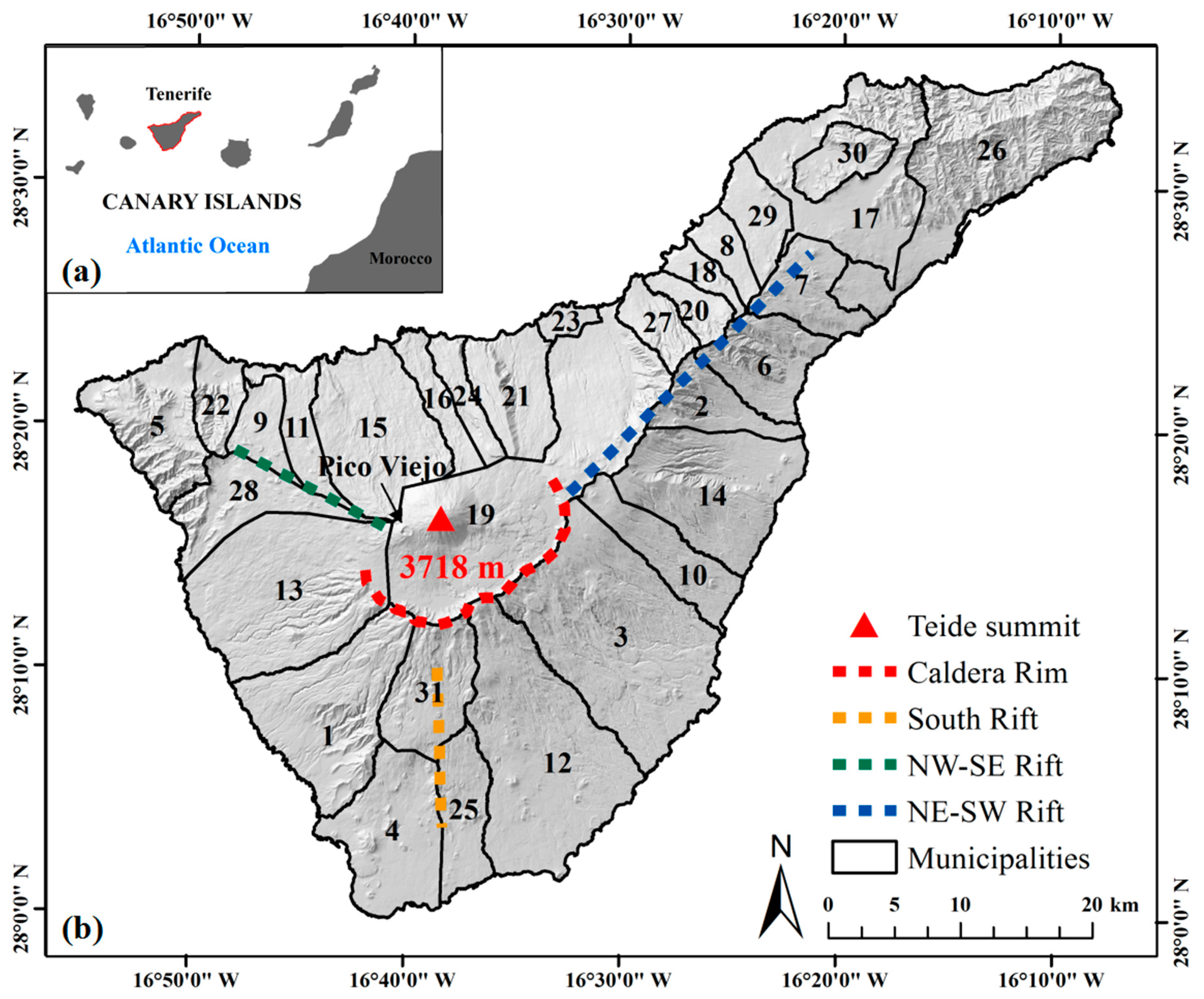
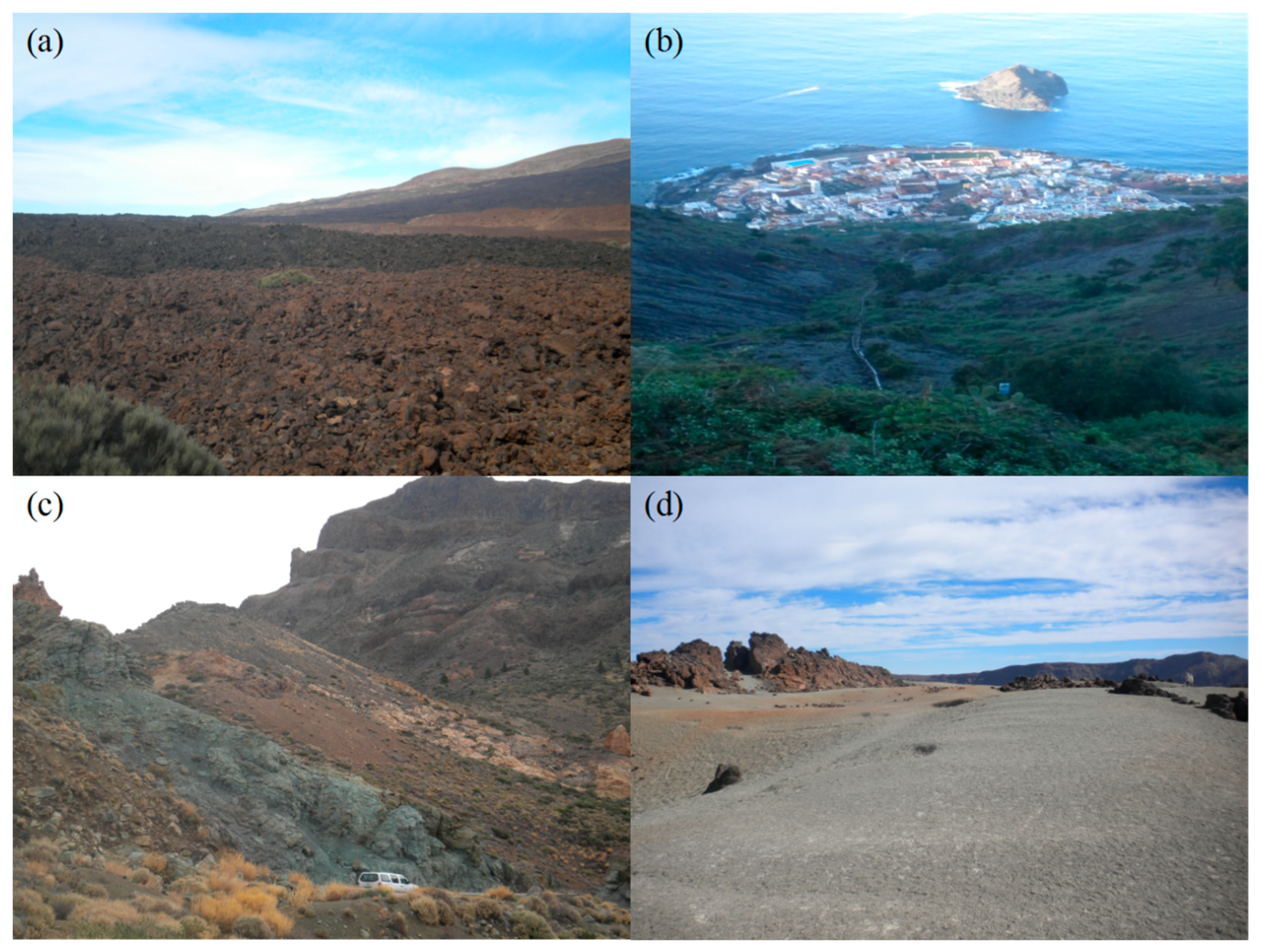
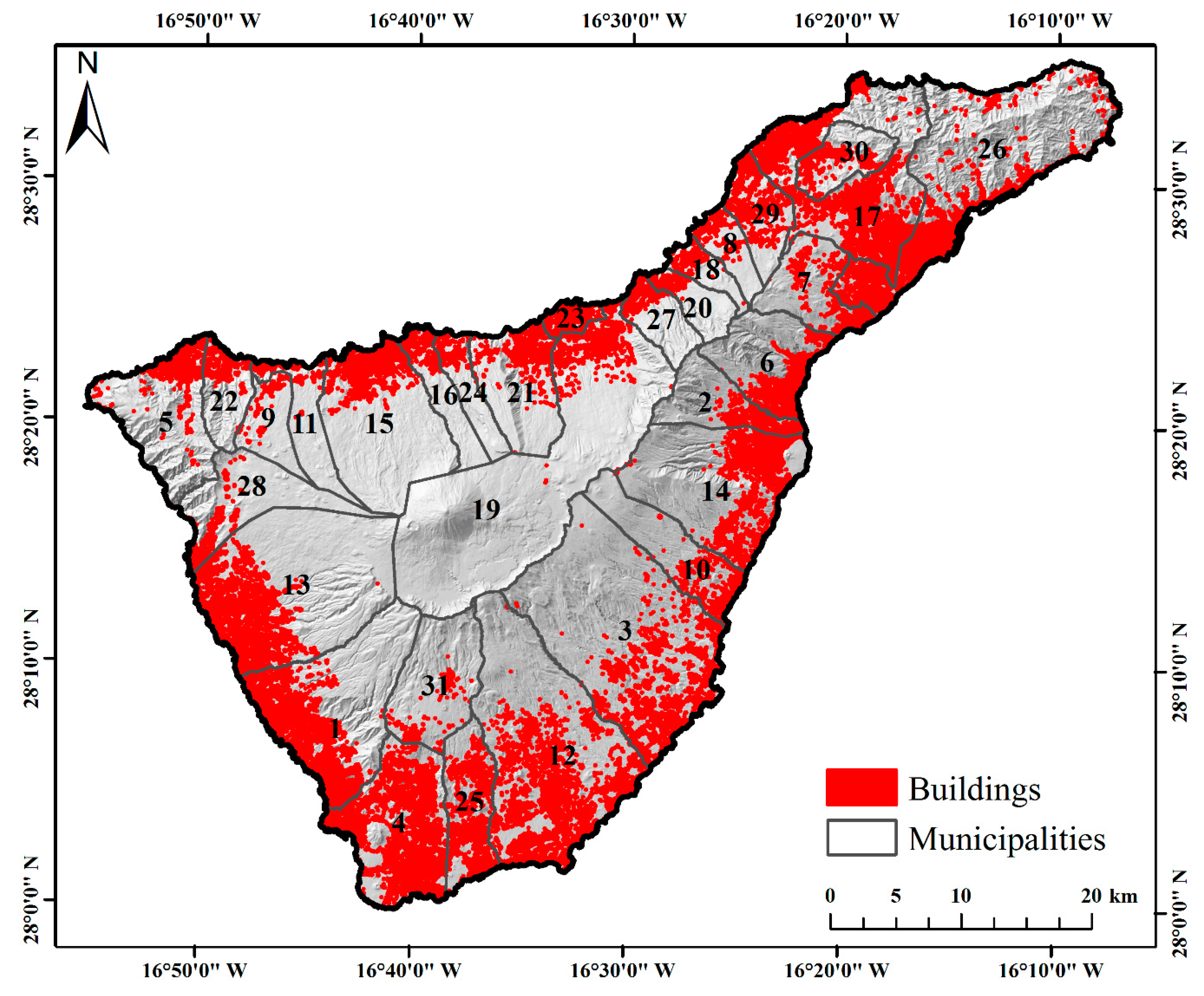
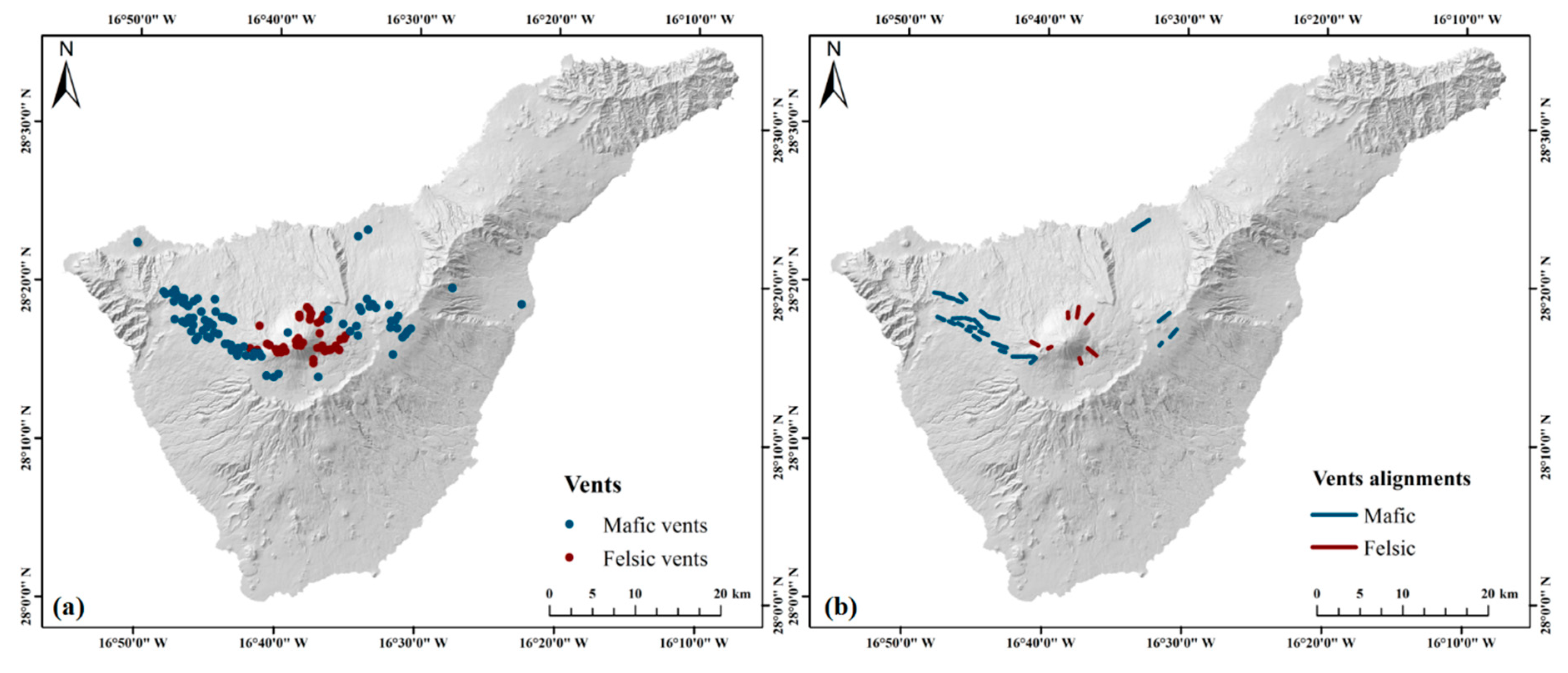
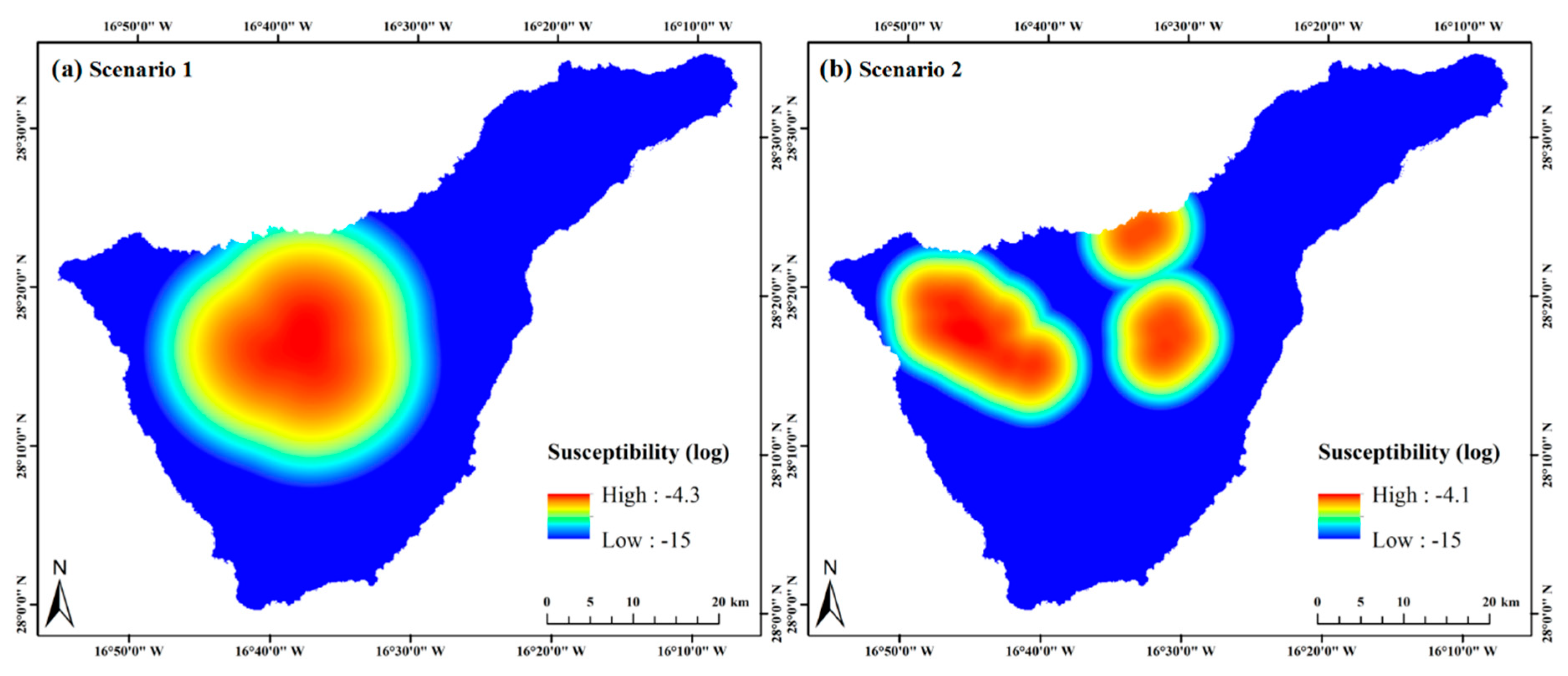
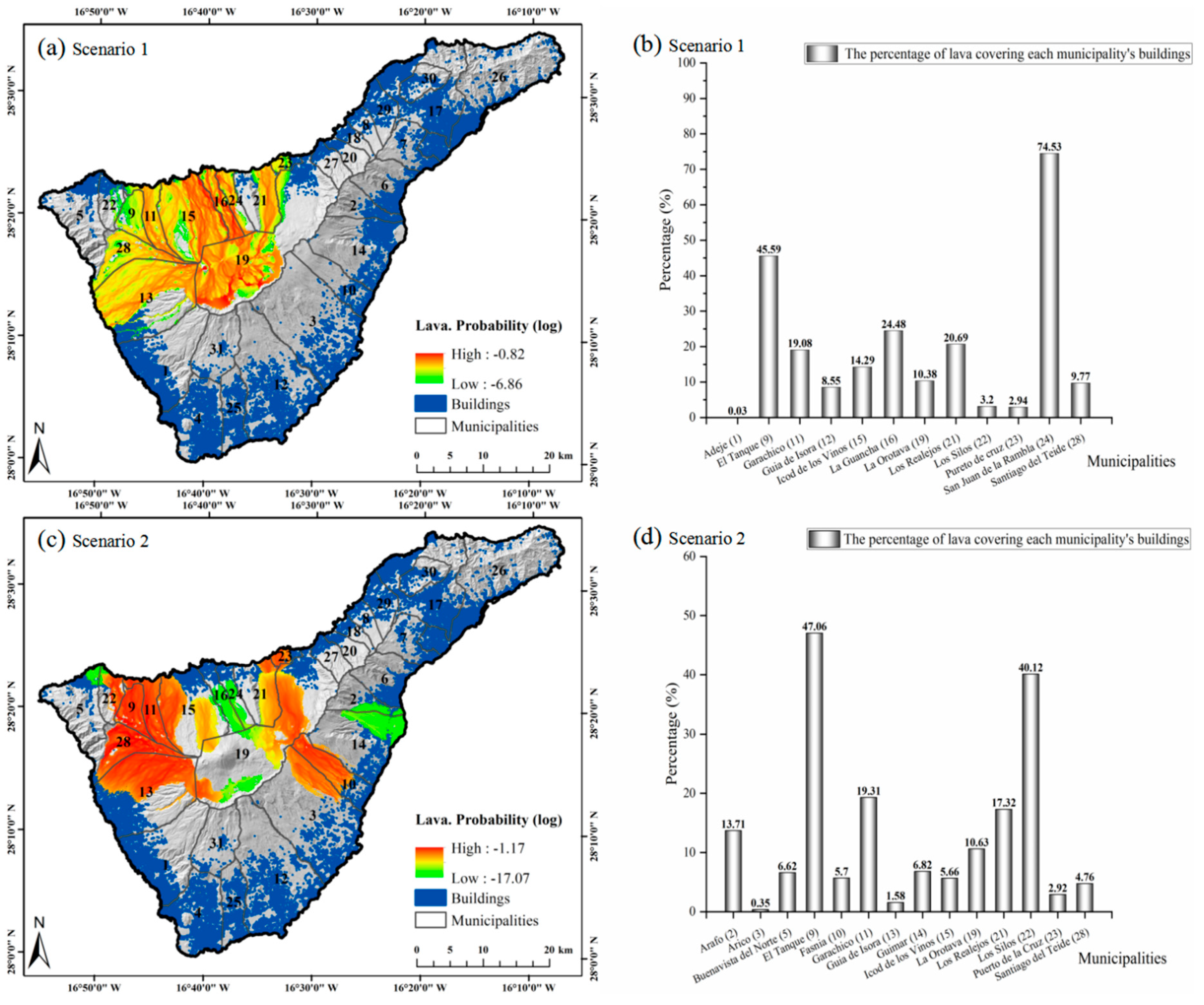
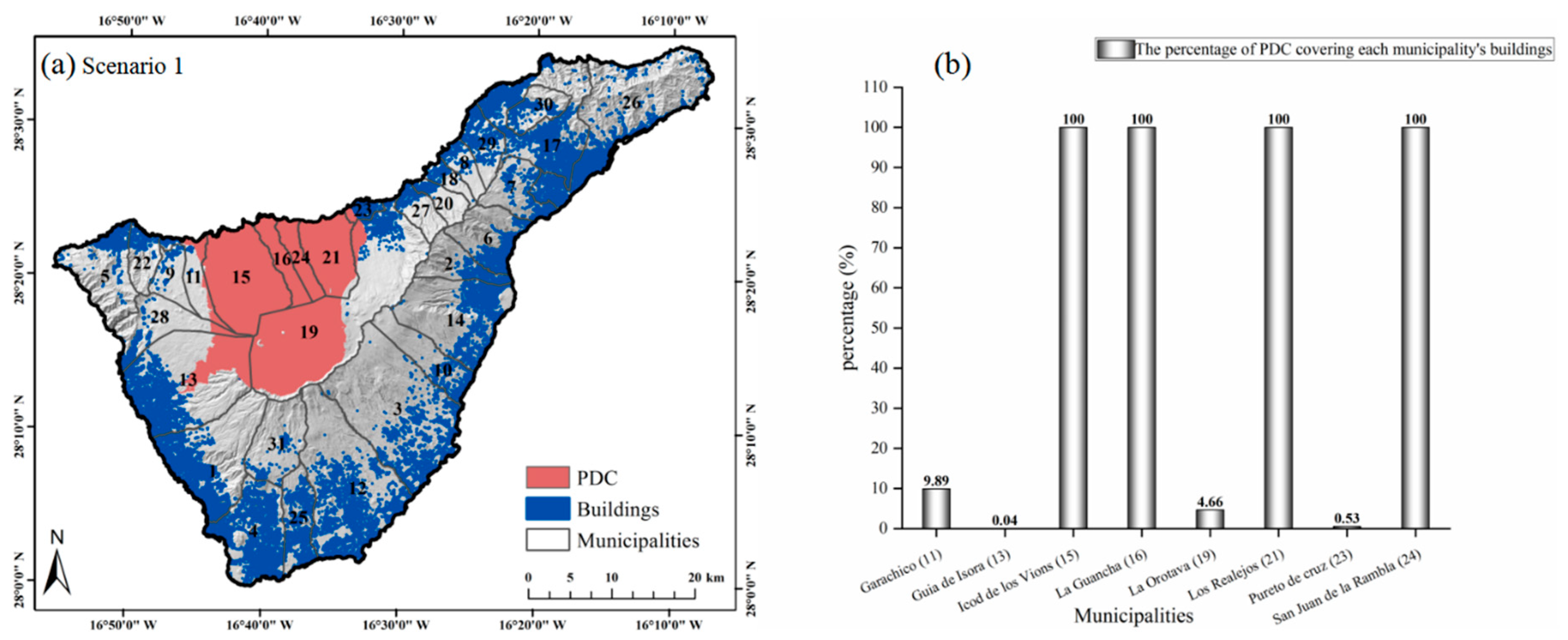
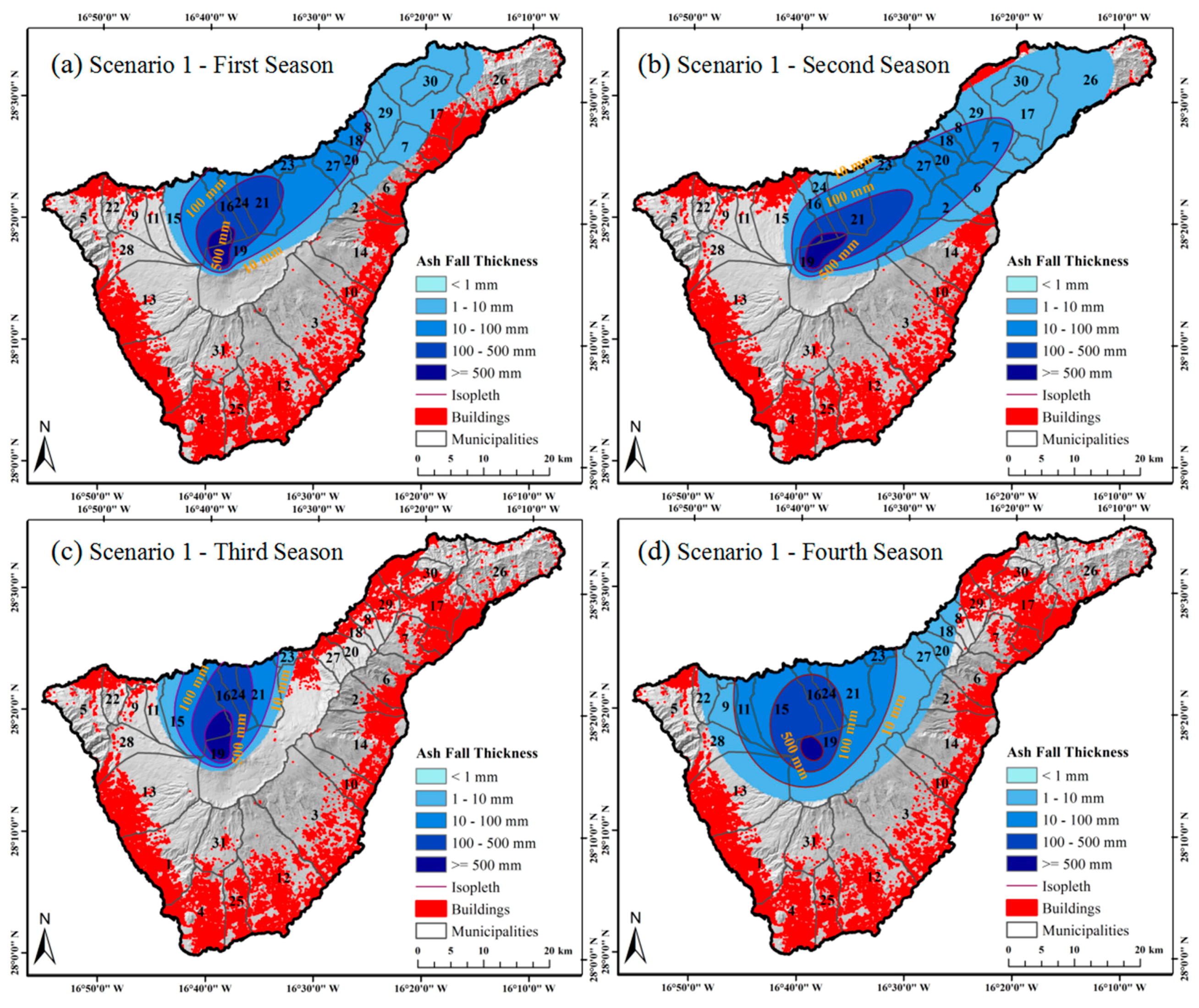
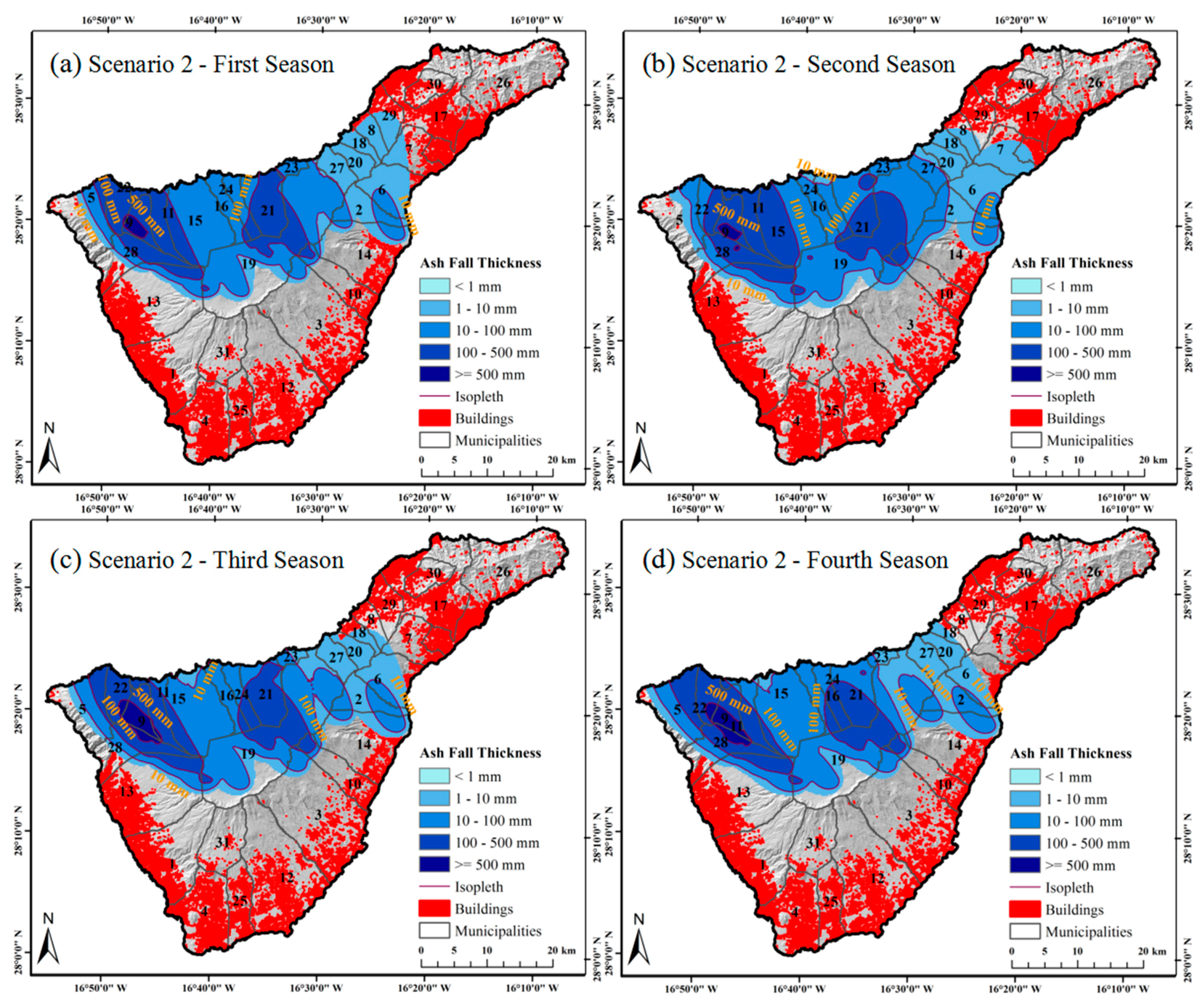

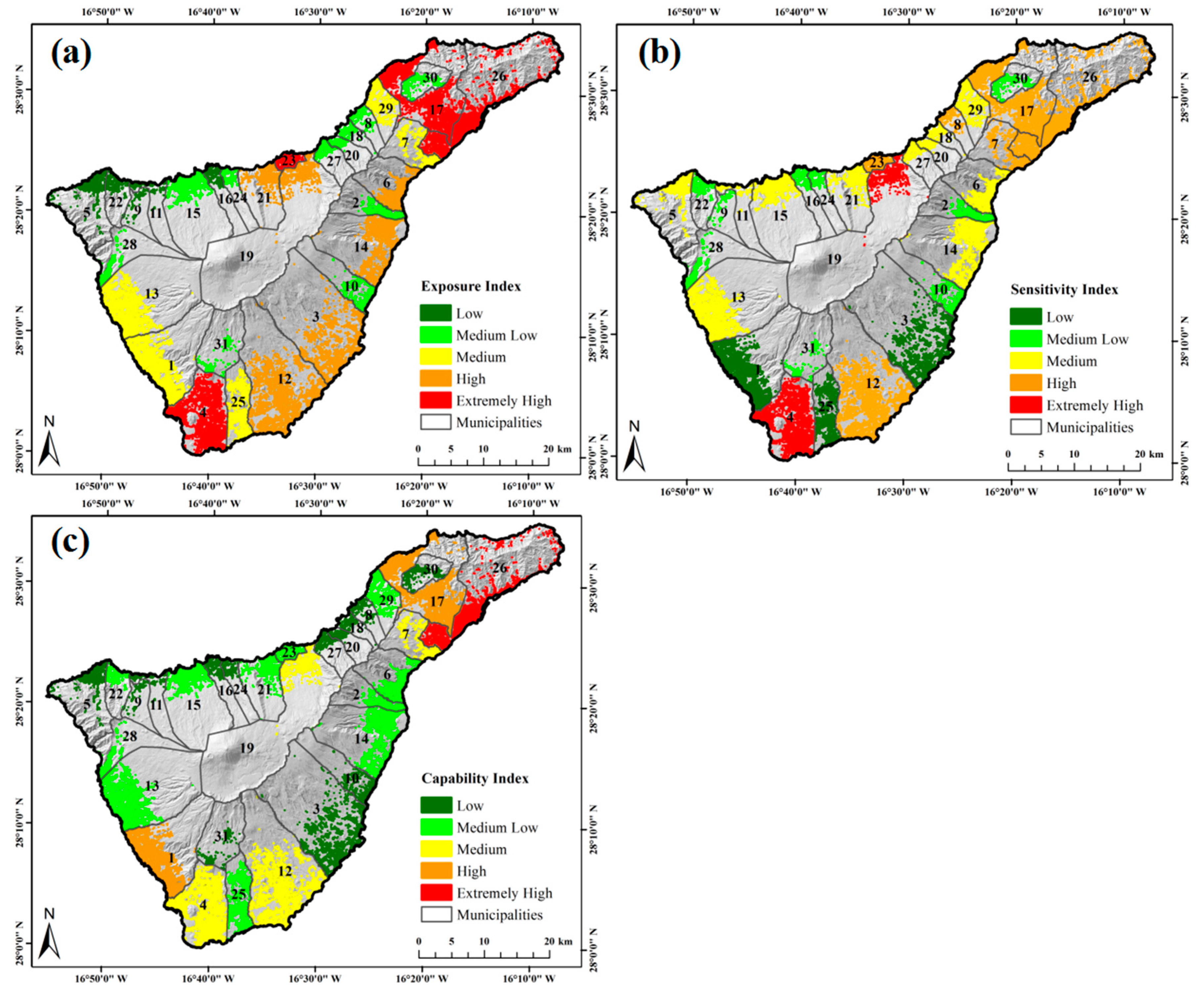
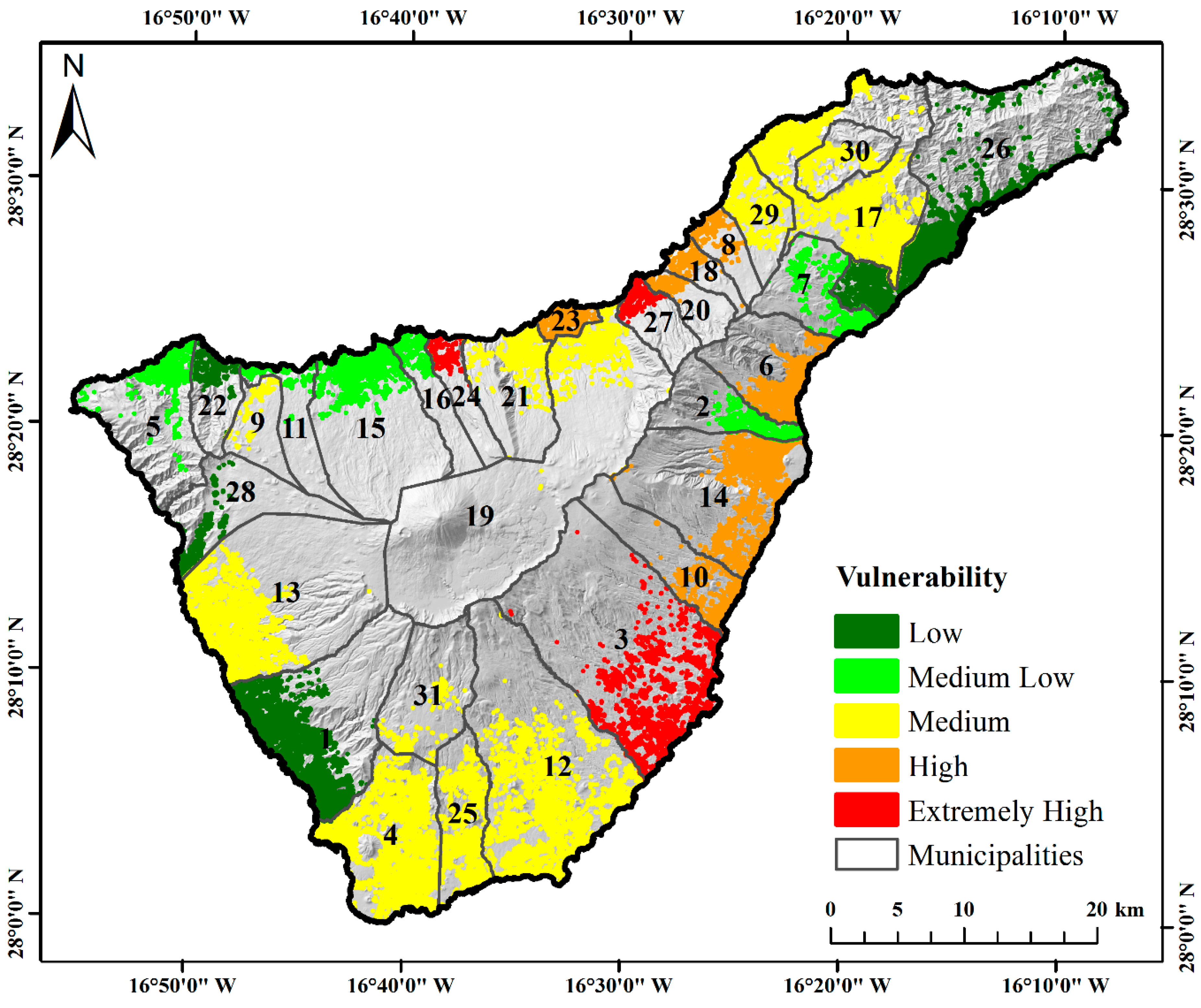
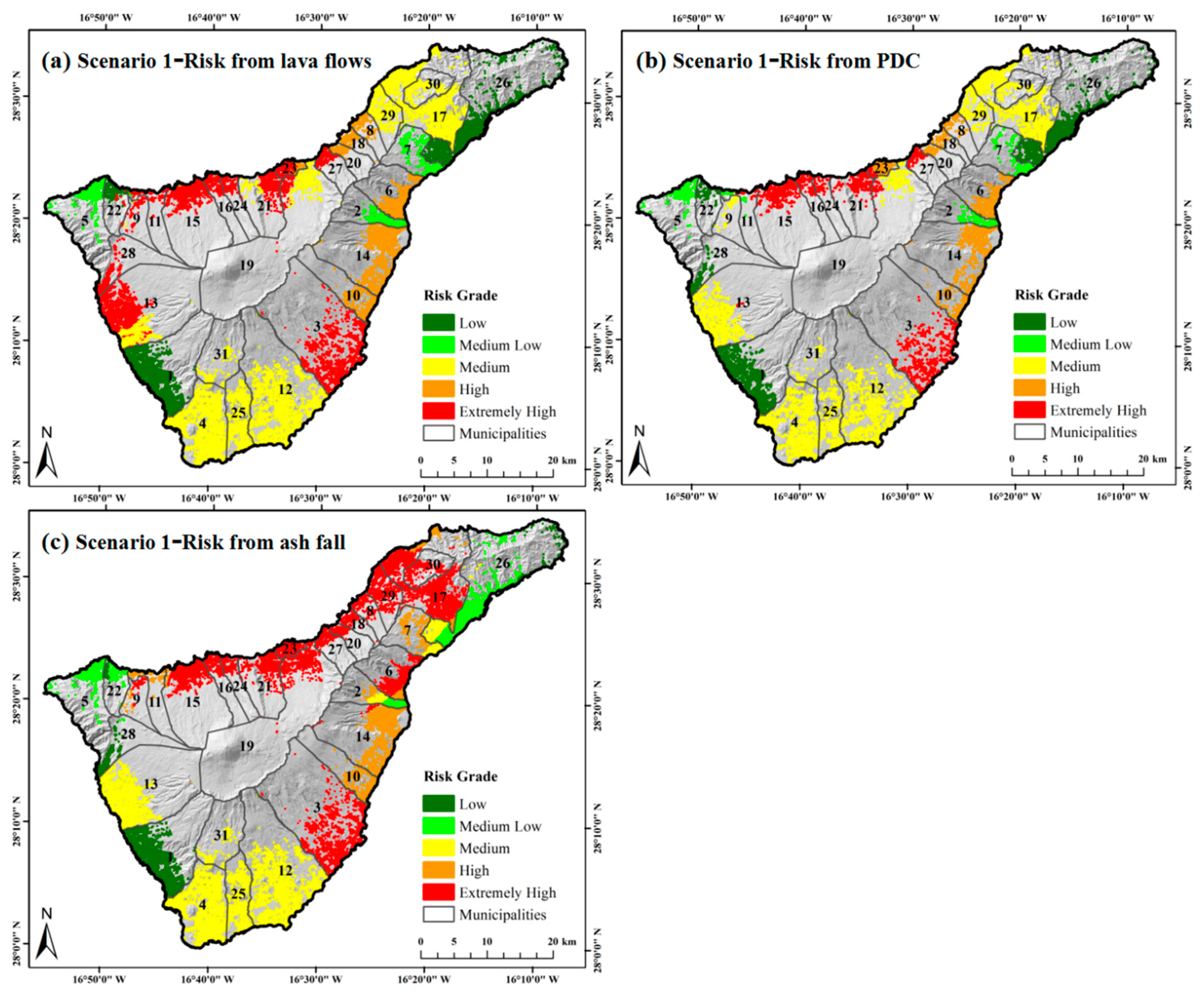
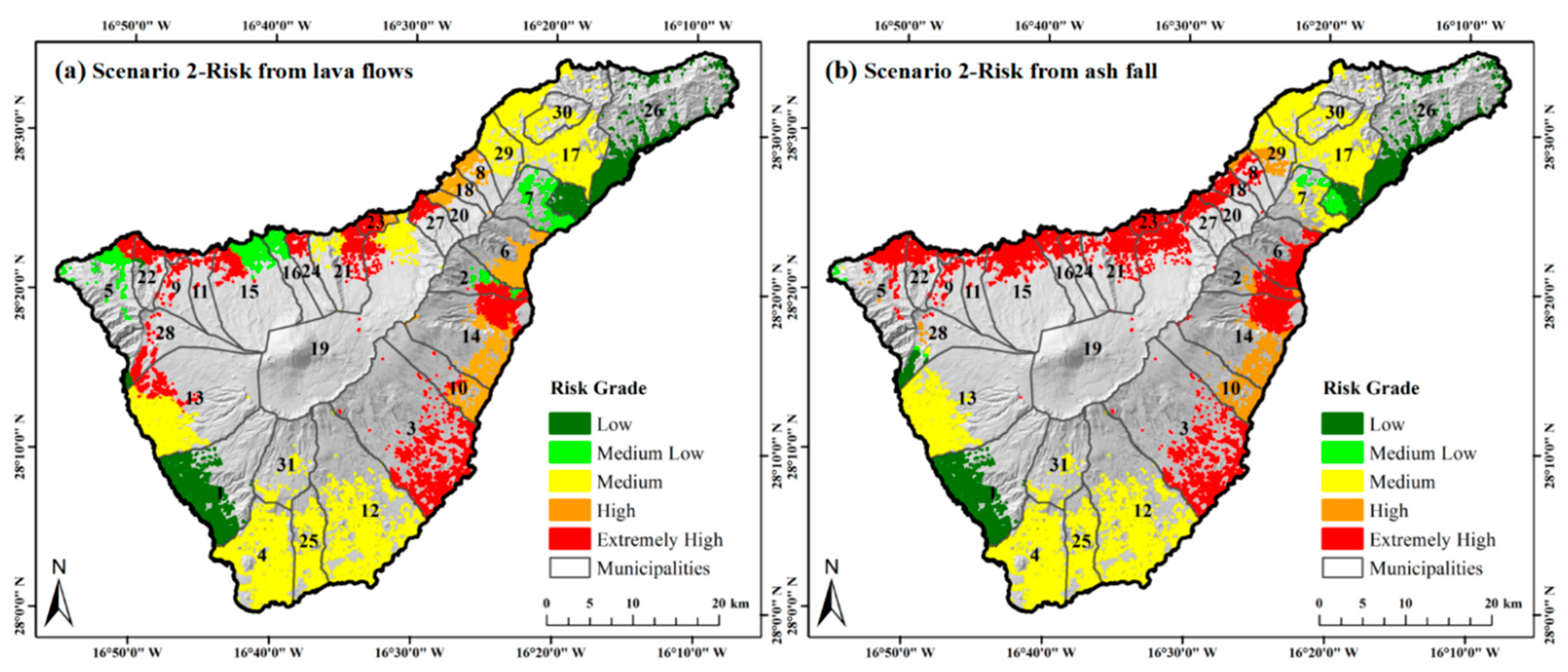
| Number | Full Name | Number | Full Name | Number | Full Name |
|---|---|---|---|---|---|
| 1 | Adeje | 11 | Garachico | 21 | Los Realejos |
| 2 | Arafo | 12 | Granadilla de Abona | 22 | Los Silos |
| 3 | Arico | 13 | Guia de Isora | 23 | Puerto de la Cruz |
| 4 | Arona | 14 | Guimar | 24 | San Juan de la Rambla |
| 5 | Buenavista del Norte | 15 | Icod de los Vinos | 25 | San Miguel de Abona |
| 6 | Candelaria | 16 | La Guancha | 26 | Santa Cruz de Tenerife |
| 7 | El Rosario | 17 | La Laguna | 27 | Santa Ursula |
| 8 | El Sauzal | 18 | La Matanza de Acentejo | 28 | Santiago del Teide |
| 9 | El Tanque | 19 | La Orotava | 29 | Tacoronte |
| 10 | Fasnia | 20 | La Victoria de Acentejo | 30 | Tegueste |
| 31 | Vilaflor |
| Category | Data and Indicators | Year |
|---|---|---|
| Infrastructure | ● Number of vehicles ● Road length ● Number of groundwater sources ● Number of hospitals ● Underground cable length | 2017 |
| 2017 | ||
| 2017 | ||
| 2017 | ||
| 2017 | ||
| Socio-economic data | ● GDP ● Per capita income ● Revenue ● Agricultural planting area | 2015 |
| 2015 | ||
| 2016 | ||
| 2017 | ||
| Administration | ● Number of firefighters ● Number of polices | 2012 |
| 2012 | ||
| Population | ● Total population ● Disabled population ● Number of passengers ● Number of Spanish passengers ● Employed population ● Low education population ● Population under 14 years old and over 65 years old | 2017 |
| 2016 | ||
| 2017 | ||
| 2017 | ||
| 2017 | ||
| 2017 | ||
| 2017 |
| Scenario 1 | Scenario 2 | |
|---|---|---|
| Ash fall | ||
| Volume | 0.05 km3 | 0.001 km3 |
| Column height | 8 km | 3 km |
| Mean grain size (φ) ±1σ | −2 ± 1.5 | 0 ± 1.5 |
| Horizontal atmospheric diffusion | 750 m2/s | 1500 m2/s |
| Lava flows | ||
| Maximum length | 30 km | 10 km |
| Height correction | 10 m | 3 m |
| Iterations | 5 × 104 | 5 × 104 |
| Pyroclastic density currents | ||
| Collapse equivalent height | 100 m | |
| Heim coefficient | 0.212 |
| Scenario 1 | Altitude (m) | Wind Direction (°) | Wind Speed (m/s) | Scenario 2 | Altitude (m) | Wind Direction (°) | Wind Speed (m/s) |
|---|---|---|---|---|---|---|---|
| First season | 500 | 118 | 6.6 | First season | 500 | 118 | 6.6 |
| 2000 | 159 | 7.8 | 1000 | 159 | 5.6 | ||
| 5000 | 231 | 9.5 | 2000 | 159 | 7.8 | ||
| 7000 | 253 | 13.2 | 3000 | 210 | 11.05 | ||
| 10,000 | 274 | 22.62 | 3500 | 198 | 10.28 | ||
| Second season | 500 | 81 | 5.3 | Second season | 500 | 81 | 5.3 |
| 2000 | 196 | 8.3 | 1000 | 162 | 3.9 | ||
| 5000 | 256 | 9.7 | 2000 | 196 | 8.3 | ||
| 7000 | 232 | 12.2 | 3000 | 233 | 8.3 | ||
| 10,000 | 232 | 17.2 | 3500 | 228 | 8.8 | ||
| Third season | 500 | 104 | 4.6 | Third season | 500 | 104 | 4.6 |
| 2000 | 147 | 7.0 | 1000 | 156 | 5.0 | ||
| 5000 | 214 | 6.6 | 2000 | 147 | 7.0 | ||
| 7000 | 200 | 7.0 | 3000 | 197 | 6.0 | ||
| 10,000 | 212 | 10.5 | 3500 | 190 | 8.5 | ||
| Fourth season | 500 | 97 | 5.2 | Fourth season | 500 | 97 | 5.2 |
| 2000 | 141 | 7.7 | 1000 | 143 | 4.9 | ||
| 5000 | 200 | 7.8 | 2000 | 141 | 7.7 | ||
| 7000 | 242 | 10.3 | 3000 | 163 | 10.3 | ||
| 10,000 | 238 | 16.5 | 3500 | 187 | 9.9 |
| Variables | Effect | References |
|---|---|---|
| Density of population | A high population density means that more of the population might be exposed to hazards. | [1,11,12,57] |
| Total number of passengers | [12] | |
| Number of Spanish passengers | Speaking the local language helps to easily get the information about hazards and evacuation. | [11,12] |
| Employed population | Employment contributes to a faster recovery from disasters. | [1,11,12,57] |
| Population under 14 years old and over 65 years old | Young and old residents may require more assistance during a hazard event. | [1,11,12,57] |
| Disabled population | Disability suggests a need for additional support and assistance in coping with hazard impacts. | [1,12,57] |
| Slope | Steep slopes increase evacuation difficulty. | [12] |
| Vehicles per capita | These factors ensure rapid mobility in evacuation. | [1,12] |
| Density of road network | [11,12] | |
| Road grade | [11,12] | |
| Number of groundwater sources | Groundwater and underground cables help to maintain basic needs of residents during and after hazards. | [11,12] |
| Underground cable length | [11,12] | |
| Number of hospitals | Medical services are needed during emergencies and in recovery. | [1,12,35] |
| Number of firemen | Firemen and police can rescue people in time and maintain social stability. | [12] |
| Number of police | [12] | |
| Revenue | Income contributes to a faster recovery from disaster. | [11,12] |
| Per capita income | [1,11,12] | |
| Agricultural planting area | Agriculture and economy suffer from hazards. | [12,35] |
| GDP | [1,11,12] |
| Goal | Objectives | Indicators | WEntropy | WAHP | W | |
|---|---|---|---|---|---|---|
| Tenerife social vulnerability assessment | Exposure | Density of population (+) | 0.226 | 0.558 | 0.392 | |
| Total number of passengers (+) | 0.090 | 0.057 | 0.073 | |||
| Agricultural planting area (+) | 0.464 | 0.122 | 0.293 | |||
| GDP (+) | 0.220 | 0.263 | 0.242 | |||
| Sensitivity | Demographic sensitivity | Low education population (+) | 0.242 | 0.058 | 0.150 | |
| Employed population (−) | 0.012 | 0.092 | 0.052 | |||
| Population under 14 years old and over 65 years old (+) | 0.221 | 0.150 | 0.186 | |||
| Disabled population | 0.142 | 0.302 | 0.222 | |||
| Number of Spanish passengers (−) | 0.036 | 0.031 | 0.034 | |||
| Environmental sensitivity | Slope (+) | 0.056 | 0.106 | 0.081 | ||
| Social sensitivity | Vehicles per capita (−) | 0.018 | 0.020 | 0.019 | ||
| Density of road network (−) | 0.014 | 0.021 | 0.018 | |||
| Road grade (−) | 0.132 | 0.001 | 0.067 | |||
| Number of groundwater sources (−) | 0.011 | 0.050 | 0.031 | |||
| Hospital (−) | 0.051 | 0.109 | 0.080 | |||
| Underground cable length (−) | 0.064 | 0.050 | 0.057 | |||
| Capability | Number of firemen (−) | 0.442 | 0.115 | 0.279 | ||
| Number of police (−) | 0.185 | 0.076 | 0.131 | |||
| Revenue (−) | 0.186 | 0.564 | 0.375 | |||
| Per capita income (−) | 0.187 | 0.244 | 0.216 |
© 2020 by the authors. Licensee MDPI, Basel, Switzerland. This article is an open access article distributed under the terms and conditions of the Creative Commons Attribution (CC BY) license (http://creativecommons.org/licenses/by/4.0/).
Share and Cite
Liu, W.; Li, L.; Chen, L.; Wen, M.; Wang, J.; Yuan, L.; Liu, Y.; Li, H. Testing a Comprehensive Volcanic Risk Assessment of Tenerife by Volcanic Hazard Simulations and Social Vulnerability Analysis. ISPRS Int. J. Geo-Inf. 2020, 9, 273. https://doi.org/10.3390/ijgi9040273
Liu W, Li L, Chen L, Wen M, Wang J, Yuan L, Liu Y, Li H. Testing a Comprehensive Volcanic Risk Assessment of Tenerife by Volcanic Hazard Simulations and Social Vulnerability Analysis. ISPRS International Journal of Geo-Information. 2020; 9(4):273. https://doi.org/10.3390/ijgi9040273
Chicago/Turabian StyleLiu, Weiqiang, Long Li, Longqian Chen, Mingxin Wen, Jia Wang, Lina Yuan, Yunqiang Liu, and Han Li. 2020. "Testing a Comprehensive Volcanic Risk Assessment of Tenerife by Volcanic Hazard Simulations and Social Vulnerability Analysis" ISPRS International Journal of Geo-Information 9, no. 4: 273. https://doi.org/10.3390/ijgi9040273
APA StyleLiu, W., Li, L., Chen, L., Wen, M., Wang, J., Yuan, L., Liu, Y., & Li, H. (2020). Testing a Comprehensive Volcanic Risk Assessment of Tenerife by Volcanic Hazard Simulations and Social Vulnerability Analysis. ISPRS International Journal of Geo-Information, 9(4), 273. https://doi.org/10.3390/ijgi9040273







